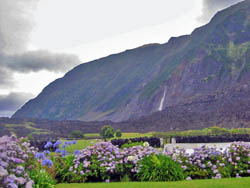|
|
 |
During heavy rain, excess water runs off the surface and into gulches, often deep ravines on the mountain slopes. These normally dry, boulder-strewn valleys suddenly fill up with water and disgorge their loads over the edge of the cliffs as waterfalls or torrents. Occasionally these sound like a thunder storm as huge boulders (up to 20 tonnes in weight) are rolled over the cliffs by the force of the water, disgorging them onto the plains below. This photograph taken on Tuesday 9th January by Janice Hentley shows the waterfall of Caves Gulch, and further east the cataracts of Plantation Gulch, as they disgorge their load of water, sand and stones to the outwash plain of Pigbite beyond the 1961 lava flow. |
